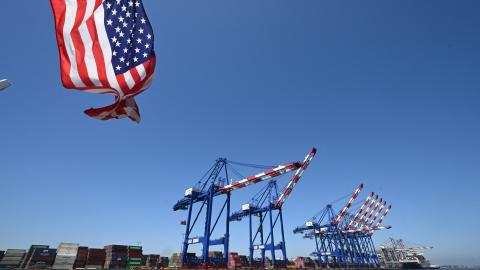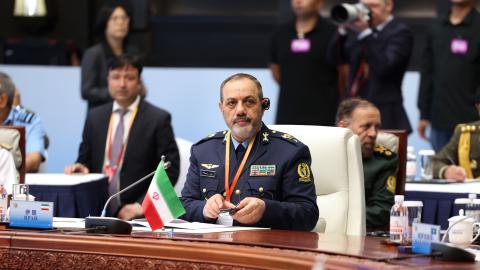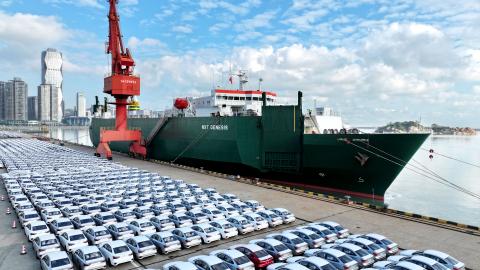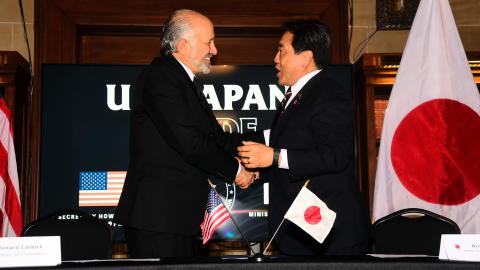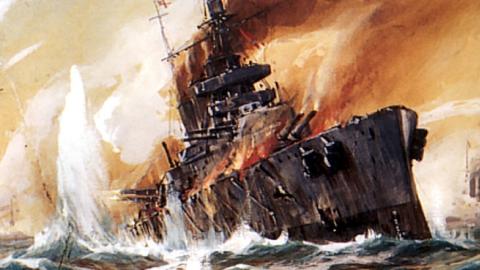May 31st marks the 100th anniversary of the Battle of Jutland. There, off the Danish coast, British and German naval forces fought as the Royal Navy sought to bottle up the German battle fleet in the North Sea and the Germans aimed to cripple the Royal Navy. In The World Crisis, Winston Churchill’s eloquent and controversial account of the Great War, the future prime minister describes the transition of the Royal Navy from its peacetime bases in southern England to its war station in Scapa Flow, Orkney:
We may now picture this great fleet with its flotillas of cruisers steaming slowly out of Portland harbor, squadron by squadron, scores of gigantic castles of steel wending their way across the misty, shining sea, like giants bowed in anxious thought.
More importantly for the officers and men aboard Churchill’s “castles of steel,” the two greatest fleets ever assembled were unknowingly steaming toward the only fleet action between dreadnought battleships.
Over eight thousand men died, many entombed in ten or twenty thousand-ton sunken steel coffins. Both Imperial Germany and the United Kingdom immediately claimed victory in the clash, but the Battle of Jutland more closely resembled a draw. Recriminations flew between high-ranking British officers for decades afterwards, which, combined with the carnage of the continental war, obscured Jutland’s valuable lessons.
A century later, as the United States allows its power to wane while its rivals strengthen, this great naval clash provides insight in three areas: strategy, technology and fleet design, and command. Applying these insights to modern strategy will help the U.S. Navy navigate an environment that is not only volatile, but could easily create multiple high-level conflict situations.
Strategy
When Sir John Jellicoe ordered the Grand Fleet to raise steam on the night of May 30th, he was executing a strategy that had been honed over the previous decade and crystallized in the years prior to war with Germany.
Chief architect of this strategy and one of the Royal Navy’s greatest reformers was Admiral “Jacky” Fisher. Fisher’s technical and personnel contributions to the Royal Navy were invaluable. Fisher, and later Churchill, understood the difference between maritime Britain and continental Germany’s strategic objectives during the Great War and welded the Royal Navy to those objectives. Germany’s industrial might and massive population made it Europe’s most powerful continental power. Against any individual enemy, Kaiser Wilhelm was justifiably confident in his army’s ability to emerge victorious. However, a protracted struggle would bleed Germany dry if it lacked access to international trade routes. Germany’s handful of overseas colonies could be quickly overrun in a major conflict, limiting its ability to respond to British naval dominance. By contrast, the United Kingdom, the lynchpin in the Triple Entente, was a maritime power with the greatest overseas empire in world history. Despite setbacks at the end of the 18th century, Britain still held significant territory in the Americas, Africa, the Middle East, and Asia, including the entirety of the Indian subcontinent. Britain’s hold on international trade routes through its control of the Suez Canal and North Sea allowed it to squeeze Germany in any conflict. Although a protracted land war was not expected, the First World War’s immense battles of attrition were the natural result of such a strategy.
Both British and German strategy required control of the North Sea. Britain had to prevent Germany from receiving seaborne trade, whereas Germany had to pressure the British home islands, first through attempts at sea control and later through submarine warfare. By knocking one enemy out of the war, Germany could then concentrate its forces against its remaining adversaries. Germany was compelled to take the strategic offensive, whereas Britain could operate on the strategic defensive, letting time work in its favor.
Fisher and his protégé Churchill understood both these grand strategies. Britain’s approach accentuated its strengths as a maritime power by emphasizing its commercial preponderance and freedom of movement. Losing control of the seas would have eviscerated the British Isles’ war effort. Additionally, a loss of sea control would have threatened the home islands themselves, since Britain’s relatively small army was wholly committed in France, leaving England, Scotland, Wales, and Ireland exposed without their naval shield. Maintaining sea control, rather than destroying the German High Seas Fleet, was Britain’s naval objective.
This strategy was an excellent counter to Germany’s naval strategy, which, if it involved surface ships rather than submarines, required a major surface engagement against the British Grand Fleet. However, Britain held appreciable superiority in dreadnought-class battleships, making a head-to-head fleet action for the Kaiserlichmarine potentially disastrous. Grand Admiral Alfred von Tirpitz, the architect of the German navy, impressed this opinion on officers throughout the Imperial Navy, encouraging its commanders to whittle away at British numbers to create a more even strategically decisive engagement.
After the Germans realized the British would establish a “far blockade” rather than directly blockading the European coastline so they could avoid mines and submarines, the Kaiserlichmarine searched for ways to draw portions of the Grand Fleet into battle. The First Scouting Group, comprised of Germany’s battlecruisers, was used together with submarines in these attempts. By both refusing to engage smaller German expeditions and using overwhelming force to drive off Imperial Navy formations, the British denied the Germans the chance to narrow the numerical gap between British and German dreadnoughts. Three lessons emerge from the strategies that led to Jutland. The first is that it is wise to emphasize strategic strengths. Predicating their strategy on sea control allowed the British to engage the Germans at the only place in which the Empire was at an appreciable disadvantage: the sea. Moreover, conducting a largely defensive strategy accentuated Britain’s long-term economic strength and undermined the German economy.
Second, understanding the enemy’s strategy was critical to overall British naval success. This understanding allowed the Grand Fleet to deny the High Seas Fleet the prelude engagements it desperately needed, creating a highly unbalanced situation at Jutland that forced the German fleet to withdraw, never to sally forth again.
Third, Jutland demonstrated that, despite technological advancements and increased scale, great naval confrontations still occurred in the contested littoral waters leading to the great sea lanes. The “Battle of Armageddon” that Fisher always predicted occurred not in sight of the cliffs of Dover, but in the North Sea, with a bottom so shallow that the battlecruiser HMS Invincible's prow and stern stuck out of the water even after it was sunk. From the confused fighting between Greek and Persian triremes at Salamis to Aboukir Bay and Trafalgar to Jutland itself, almost all fleet actions occur in the shallow approaches to the great sea-lanes. The engagements of fleets are tactical reflections of strategic struggle between great nations of empires. Command at sea is fought for chokepoints and access to a continent’s gateways; it is not an end in itself.
All three lessons have direct applications for the United States. First, American strategy should play to its strengths and mitigate its weaknesses. The United States possesses a global alliance network, a highly advanced conventional military, and it sits at the center of an international commercial system. The United States can use this broad alliance network to fight wars away from its borders while it shifting assets rapidly between regions threatened by adversaries. Coupled with an alliance system, reliance upon and expansion of U.S. seapower allows the United States to defend allies, the international order, and ultimately, itself. An effective Navy ensures that the United States can deliver force against targets in multiple contested regions, including areas where no ally exists to offer America basing rights. Understanding the strengths and weaknesses of America’s major adversaries ensures that overall strategy also pressures their vulnerabilities. Though Russia’s military is more advanced than it has been in decades, its economy remains unstable and dependent on events beyond its control, while significant ethnic minorities continue to resist Moscow. Russian President Vladimir Putin also faces the danger of overextension, which at a minimum aided the collapse of the Tsarist and Communist empires. By forcing Russia to pay a high price for attempted conquests and extricating American allies from the Russian energy market, Washington can undermine Moscow over time.
China’s massive productivity and ownership of American national debt give it significant influence over the United States. Beijing has also significantly increased its military capabilities, allowing it to threaten America’s ability to mass forces in the Pacific and concurrently bully its neighbors into submission. However, China must import to meet its energy needs, whereas the United States will be able to meet its own needs with domestic production in the near future. If the United States can prevent China from importing oil — largely still transported by massive tankers — it can diminish Beijing’s ability to outlast and defeat the United States in a protracted conflict. The string of island states in the Pacific that bracket the Chinese coastline enable this approach. Assuring their security inspirits their own efforts to defend themselves.
Iran couples its energy-based economy with a highly effective irregular force that cultivates instability in the surrounding region to create a buffer around the Islamic Republic. However, its economy remains weak after decades of sanctions, and its prosperity depends upon access to the sea lanes. Like Fisher and Churchill, American strategists will succeed by emphasizing America’s strengths, targeting its adversaries’ economic vulnerabilities, and dominating control of global sea lanes.
Finally, the United States should assume future confrontations will occur in contested coastal regions. The South and East China Sea, Arabian Gulf, Eastern Mediterranean, and Baltics all fit this geographic profile. Preparing for conflicts over control in these regions, rather than creating forces to project power from sea to shore, is in the U.S. Navy’s strategic interest.
Technology and Fleet Design
The First World War introduced a variety of new technologies to the battlefield on a large scale, including the submarine, the airplane, and chemical weapons. Naval technological developments before Jutland and their corresponding impact on fleet design hold lessons about the relation between strategy and technology.
The HMS Dreadnought, launched in 1906, was Jacky Fisher’s brainchild, the culmination of his career of innovation. The Dreadnought's big-gun design and high speed rendered all “pre-dreadnought” battleships obsolete. It is no wonder that Churchill, when explaining his plans to force the Narrows at Gallipoli, proposed that the Navy use almost exclusively pre-dreadnoughts. The loss of those ships would not damage the Royal Navy’s fighting strength in the North Sea. Fisher’s ability to ensure secrecy surrounding the design and production of the Dreadnought allowed the Royal Navy to surprise the Kaiserlichmarine with the battleship’s final commissioning and gave Britain a significant head start over Germany in producing more ships of the same class, which created the numerical disparity that proved critical at Jutland.
HMS Dreadnought, and all following Dreadnought-class battleships, were designed with the sole purpose of destroying other battleships in major fleet engagements. However, this does not provide a lesson to strategists — it simply describes the role of the capital ship. Instead, Fisher’s later developments demonstrate the need to transform dominant technology into strategic superiority.
Fisher followed up the Dreadnought project with the concept of the Battlecruiser — a lightly armored, fast “cruiser-killer” that could catch and destroy armored cruisers, the midlevel mainstay of world navies. Armored cruisers were designed to defeat anything smaller than a battleship and outrun any capital ship. The battlecruiser combined the speed of the armored cruiser with the big-gun armament of the dreadnought battleship, while sacrificing armor to save weight. With the commissioning of the first Invincible-class battlecruiser, Fisher had once again revolutionized naval construction and outwitted his chief German rival, Admiral Tirpitz. The Grand Admiral had commissioned the SMS Blucher, a 17,000-ton armored cruiser, to respond to the construction of the Invincible. The Invincible's 12-inch guns rendered obsolete the Blucher, with its 8.3-inch guns, along with every other German armored cruiser.
Fisher knew how to use technological development for strategic ends. Because he never lost sight of the role of the fleet, each of its ships the Grand Fleet at Jutland was the product of a technological innovation that aimed at strategic results. Adapting technology to strategic needs and then using technological development to subdue an opponent is the great lesson that Jutland provides.
Jutland also provides two major “negative” lessons. First, Jutland demonstrated the need to ensure that platforms are used for their proper role. The only British capital ships lost at Jutland were battlecruisers, specifically from David Beatty’s First Battlecruiser Squadron during the “Run to the South” and “Run to the North” in the first engagements with the High Seas Fleet. Beatty made his famous comment, “There seems to be something wrong with our bloody ships today,” after two of his battlecruisers exploded. Beatty refused to use the battlecruiser’s speed and range to harass the enemy and instead engaged in a high-risk slugging match with his lightly armored ships as if they were true battleships. The result was that Britain lost three battlecruisers. This is another of Jutland’s lessons — failing to maximize a platform’s strengths can lead to major tactical setbacks.
Second, Jutland reaffirmed the importance of engaging in sustained combat, despite the major offensive capability of large combat vessels. Fisher consistently emphasized the maxim “hit first, hit hard” — big guns mounted on fast ships would end engagements quickly and decisively with high firepower. Jutland emphasized the importance of traditional sustained combat, despite advances in offensive technology.
Jutland’s technological lessons are particularly applicable today. Fisher emphasized complete and rapid modernization throughout his career in the Royal Navy. He even scrapped older ships to free up sailors and funds for newer vessels, especially after the Dreadnought was launched. Unafraid of criticism from traditionalists, Fisher eschewed custom in every regard, allowing him completely to remake the Royal Navy into a modern fighting machine. Decades later, when Britain again plunged into a global conflict with Churchill at the helm, Fisher’s ships served as the backbone of the Royal Navy.
Today, the U.S. Navy, and more broadly all American military services, have accepted that unmanned systems will play a major role in military operations in the near future. In particular, the sea services frequently discuss pairing manned and unmanned platforms in various combat roles and using unmanned systems to multiply the combat power and range of manned assets. “Every platform must be a sensor-sharer-shooter,” said Marine Deputy Commandant for Aviation Lt. Gen. John Davis this past week. However, praising innovation does not equal rapidly and effectively disseminating new technologies in a strategically relevant manner. Deploying the carrier-launched drones in limited numbers, giving submarines the ability to launch drones, or linking unmanned and manned helicopters together for anti-submarine warfare missions do not have significant strategic implications. They do not go far enough. They do not embrace a revolution in military technology, as construction of the Dreadnought in 1906 did. If the U.S. Navy and the U.S. military as a whole remain content with simply “integrating” unmanned systems into currently deployed forces, they are destined, like the armored cruiser, to be gobbled up by an adversary that does embrace innovation.
Command
Jutland provides lessons on officer selection to modern strategists that are directly relevant in an increasingly globalized strategic environment. Both British and German commanders, John Jellicoe and Reinhard Scheer, had a superb grasp of the strategic goals of their countries. Jellicoe understood the need to preserve British naval supremacy in the North Sea, even at the cost of ceding the tactical initiative at certain times to the High Seas Fleet. Jellicoe also understood the need for constant preparation for a fleet action to ensure that a major sortie would not catch the British by surprise. Jellicoe’s opponent, Scheer, understood Germany’s overall strategy and where the Imperial Navy fit into executing it.
By attempting to provoke a smaller surface engagement, Scheer put the disadvantaged Kaiserlichmarine in the best possible position to whittle down the Royal Navy’s battleship advantage. When confronted with overwhelmingly superior numbers at Jutland, Scheer had the presence of mind to reverse course with a “battle about turn” maneuver. Even when his instinct for offensive tactics led him to his only major mistake of the battle, turning back to engage the British battle line, Scheer was able to recover by sacrificing the Scouting Group in a suicidal charge — now known as the “Death Ride” — and withdraw the bulk of his fleet safely. If the German political situation had been slightly different, Scheer may have been handed another chance to draw out portions of the Grand Fleet or harass it with submarines, thereby evening the odds for a fleet action. Jutland teaches that having commanders with an iron grasp of grand strategy is invaluable for maximizing assets and limiting damage over time.
Conclusion
Jutland’s inconclusive tactical outcome has obscured the important lessons that the battle and its prelude offer to modern strategists. At the strategic level, Jutland demonstrates the need to maximize strengths while attacking the enemy’s weak points on a grand scale. Technologically, Jutland provides an example of “strategically relevant technological development.” The naval arms race that created the great fleets that clashed at Jutland was conducted with a specific strategic goal; the technological advancements that the dreadnought and battlecruiser provided were felt beyond the battle space. Finally, it is critical to have commanders with a firm grasp of strategic goals, especially at sea, where recovering losses is extremely difficult.
Jutland provides critical lessons for today, on strategy, technological development and integration, and command. However, the most enduring lesson of Jutland is the consistently random nature of combat. No matter how thorough the strategies, how well-developed the technologies, and how decorated the commanders, warfare still boils down to a small number of decisive moments where chance dictates the life and death of thousands. As Jellicoe paced the bridge of the Iron Duke, waiting in vain for Beatty to inform him of the location of the High Seas Fleet’s battle squadrons, he was faced with a single choice: head west toward the open sea or southeast toward Denmark. The wrong choice would have turned his line parallel to its German counterpart, leading to an extended duel between the two fleets. With equivalent gunnery, better shells, sturdier ships, and more torpedo-armed destroyers, the Germans would have had a chance to diminish the Grand Fleet. Waiting any longer would have allowed a well-ordered German battle line to fall upon a disorganized mass of dreadnoughts and eviscerate the British fleet.
Jellicoe chose to change course southeast, bringing his titans into a single battle line of steel and smoke. As his ships assumed station, the Germans erupted out of the fog, the British perfectly crossing their “T.” The pride of the Royal Navy spat fire and cordite, beginning the fleet action and battering the Imperial battle line.
Scheer’s escape later that night, enabled by poor communication between British squadrons, could not have been predicted. However, through strategy, technological innovation and integration, and command talent, Fisher and Churchill had prepared for the worst in the best possible way. That multiple uncontrollable factors led to a tactical draw does not diminish the need for such preparation. On a global battlefield characterized as much by increasing uncertainty as by the U.S. interest in supporting states that uphold a liberal international order, strategic, technological, and command superiority is still a prerequisite for naval dominance.
